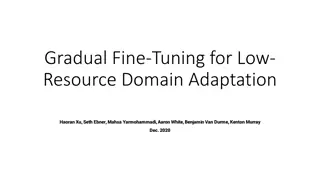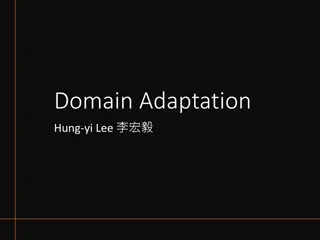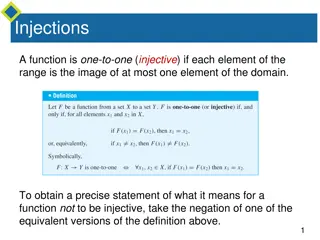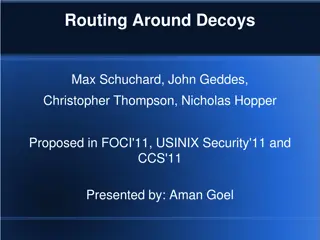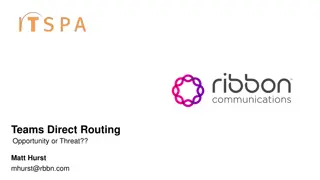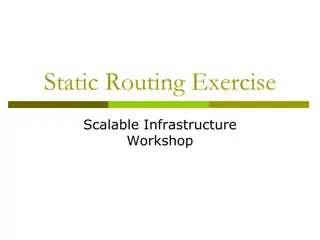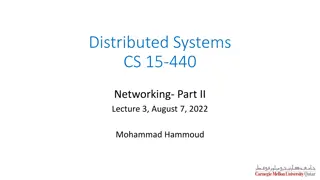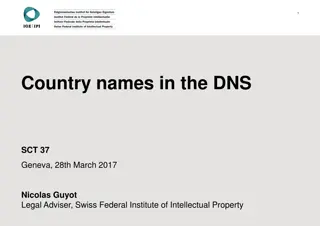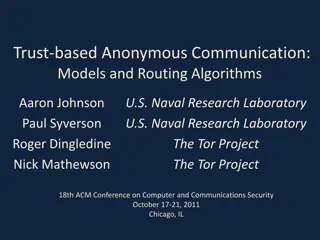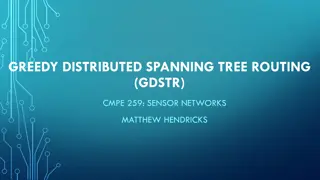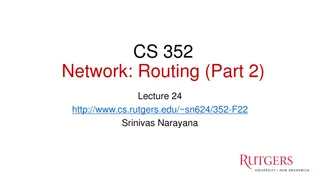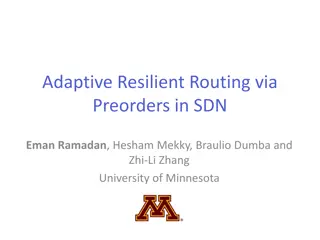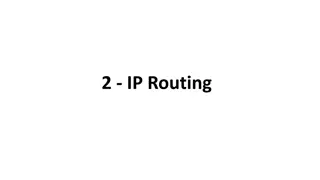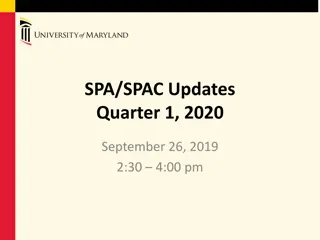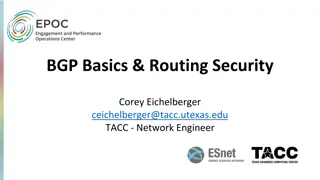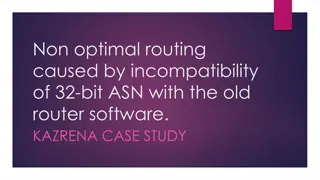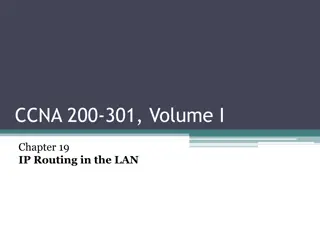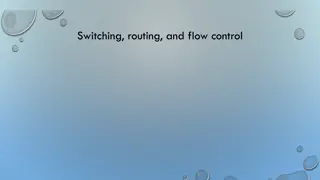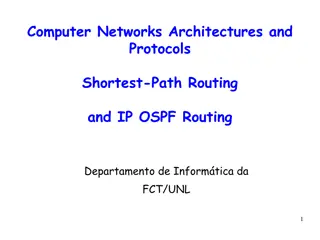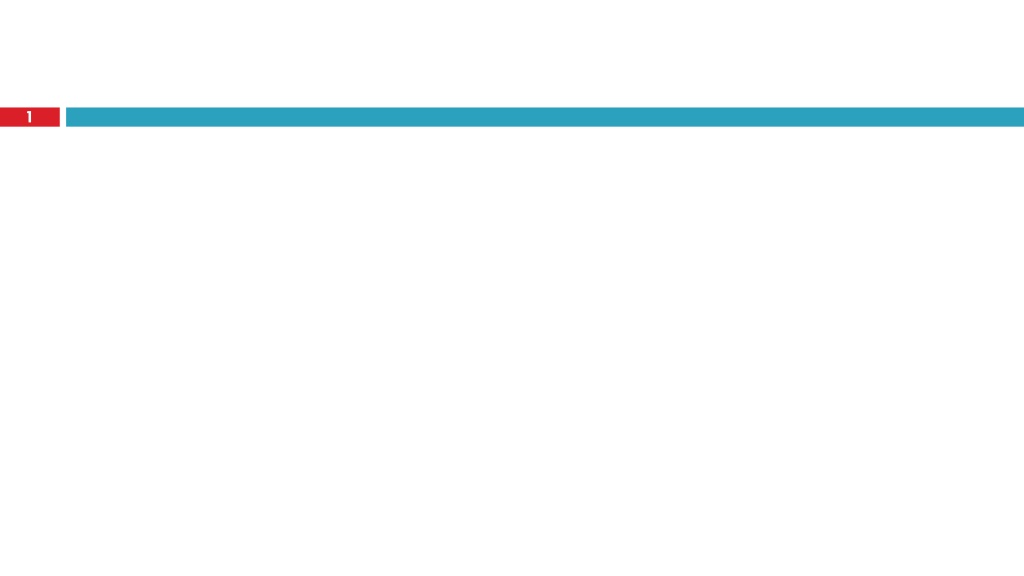
Networking Concepts and Exercises
Learn about CIDR representations, subnet masks, network division, routing aggregation, Internet hierarchy, AS examples, and the importance of Autonomous Systems in networking. Explore various exercises related to network addressing and routing. Understand the control plane, data plane, and different routing protocols in networking.
Download Presentation

Please find below an Image/Link to download the presentation.
The content on the website is provided AS IS for your information and personal use only. It may not be sold, licensed, or shared on other websites without obtaining consent from the author. If you encounter any issues during the download, it is possible that the publisher has removed the file from their server.
You are allowed to download the files provided on this website for personal or commercial use, subject to the condition that they are used lawfully. All files are the property of their respective owners.
The content on the website is provided AS IS for your information and personal use only. It may not be sold, licensed, or shared on other websites without obtaining consent from the author.
E N D
Presentation Transcript
Exercises 2 What are the CIDR representations of these networks? 18.0.19.0/255.255.255.0 182.16.0.0/255.255.254.0 82.192.0.0/255.192.0.0 129.10.17.64/255.255.254.128 What are the subnet mask representations of these networks? 56.39.0.0/16 194.17.4.0/22 93.32.0.0/13 0.0.0.0/0
More exercises 3 Suppose you were given the network 18.32.0.0/15. You need to divided it into two equal pieces. How do you do so and what are those network addresses in CIDR notation? What if you were given the network 165.17.14.0/23. How would you divide it?
Even more exercises 4 Suppose you are a router and your routing table is shown at left. Can you aggregate any of those rules? If so, show the updated rule(s). Destination Next Hop 0.0.0.0/0 Port 1 129.10.128.0/24 Port 2 129.10.130.0/23 Port 3 129.10.127.0/24 Port 2 129.10.0.0/17 Port 4 129.10.129.0/24 Port 2
CS 3700 Networks and Distributed Systems Intra Domain Routing Revised 10/05/20
Network Layer, Control Plane 6 Function: Set up routes within a single network Key challenges: Distributing and updating routes Convergence time Avoiding loops Data Plane Application Presentation Session Transport Network Data Link Physical Control Plane RIP OSPF BGP
Internet Routing 7 Internet organized as a two level hierarchy First level autonomous systems (AS s) AS region of network under a single administrative domain Examples: Comcast, AT&T, Verizon, T-Mobile, etc. AS s use intra-domain routing protocols internally Distance Vector, e.g., Routing Information Protocol (RIP) Link State, e.g., Open Shortest Path First (OSPF) Connections between AS s use inter-domain routing protocols Border Gateway Routing (BGP) De facto standard today, BGP-4
AS Example 8 AS-1 AS-3 Interior Routers AS-2 BGP Routers
Why Do We Have ASs? 9 History the Internet started as a network of networks Routing algorithms are not efficient enough to execute on the entire Internet topology Different organizations may use different routing policies Allows organizations to hide their internal network structure Allows organizations to choose how to route across each other (BGP) Easier to compute routes Greater flexibility More autonomy/independence
Routing on a Graph 10 Goal: determine a good path through the network from source to destination What is a good path? Usually means the shortest path Load balanced Lowest $$$ cost 5 3 B C 5 2 2 1 A F 3 Network modeled as a graph Routers nodes Link edges Edge cost: delay, congestion level, etc. 2 1 E D 1
Routing Problems 11 Assume A network with N nodes Each node only knows Its immediate neighbors The cost to reach each neighbor 5 3 B C 5 2 How does each node learn the shortest path to every other node? 2 1 A F 3 2 1 E D 1
Intra-domain Routing Protocols 12 Link state Open Shortest Path First (OSPF), based on Dijkstra Each router periodically floods immediate reachability information to all other routers Per router local computation to determine full routes Distance vector Routing Information Protocol (RIP), based on Bellman-Ford Routers periodically exchange reachability information with neighbors 12
Outline 13 Link State Routing OSPF IS-IS Distance Vector Routing RIP
Link State Routing 14 Each node knows its connectivity and cost to direct neighbors Each node tells every other node this information Each node learns complete network topology Use Dijkstra to compute shortest paths
Flooding Details 15 Each node periodically generates Link State Packet ID of node generating the LSP List of direct neighbors and costs Sequence number (64-bit, assumed to never wrap) Time to live Flood is reliable (ack + retransmission) Sequence number versions each LSP Receivers flood LSPs to their own neighbors Except whoever originated the LSP LSPs sent when link states change
Dijkstras Algorithm 16 B C D E F Step S 0 A 2, A 5, A 1, A 1 AD 4, D 2, D 2 ADE 3, E 4, E 3 ADEB 4 ADEBC 5 ADEBCF 5 8. 9. 10. add w to S; 11. update D(v) for all v adjacent to w and not in S: 12. D(v) = min( D(v), D(w) + c(w,v) ); 13. until all nodes in S; 1. 2. 3. 4. 5. 6. Initialization: S = {A}; for all nodes v if v adjacent to A then D(v) = c(A,v); else D(v) = ; Loop find w not in S s.t. D(w) is a minimum; 3 B C 5 2 2 1 A F 3 1 2 E D 1
OSPF vs. IS-IS 17 Two different implementations of link-state routing OSPF IS-IS Favored by companies, datacenters More optional features Favored by ISPs Less chatty Less network overhead Supports more devices Not tied to IP Built on top of IPv4 LSAs are sent via IPv4 OSPFv3 needed for IPv6 Works with IPv4 or IPv6
Different Organizational Structure 18 OSPF IS-IS Organized around overlapping areas Organized as a 2-level hierarchy Area 0 is the core network Level 2 is the backbone Level 1-2 Level 1 Level 2 Area 2 Area 1 Area 0 Area 4 Area 3
Outline 19 Link State Routing OSPF IS-IS Distance Vector Routing RIP
Distance Vector Routing 20 What is a distance vector? Current best cost to reach all known destinations Idea: exchange vectors among neighbors to learn about lowest cost paths No entry for C Destination Cost Initially, only has info for immediate neighbors A 7 DV Table at Node C B 1 D 2 Other destinations cost = E 5 Eventually, vector is filled F 1 Routing Information Protocol (RIP)
Distance Vector Routing Algorithm 21 Wait for change in local link cost or message from neighbor 1. Recompute distance table 2. If least cost path to any destination has changed, notify neighbors 3.
Distance Vector Initialization 22 Node B Node A 3 B D Dest. Cost Next Dest. Cost Next 2 1 B 2 B A 2 A 1 C 7 C C 1 C A C 7 D D 3 D 1. 2. 3. 4. 5. 6. Initialization: for all neighbors V do ifV adjacent to A D(A, V) = c(A,V); else D(A, V) = ; Node D Node C Dest. Cost Next Dest. Cost Next A 7 A A B 1 B B 3 B D 1 D C 1 C
Distance Vector: 1st Iteration 23 Node B Node A 3 B D Dest. Cost Next Dest. Cost Next 2 1 B 2 3 B A 2 A 1 C B C 7 C 1 C A C 7 D 8 5 D 3 2 D C C B 7. 12. 13. 14. 15. 16. 17. 18. 19. 20. loop: else if (update D(V, Y) received from V) for all destinations Y do if (destination Y through V) D(A,Y) = D(A,V) + D(V, Y); else D(A, Y) = min(D(A, Y), D(A, V) + D(V, Y)); if (there is a new min. for dest. Y) send D(A, Y) to all neighbors forever D(A,C) = min(D(A,C), D(A,B)+D(B,C)) = min(7, 2 + 1) = 3 D(A,D) = min(D(A,D), D(A,B)+D(B,D)) Node D Node C D(A,D) = min(D(A,D), D(A,C)+D(C,D)) = min( , 7 + 1) = 8 = min(8, 2 + 3) = 5 Dest. Cost Next Dest. Cost Next 7 3 A B 4 B A A B 1 B B 3 B D 1 D C 1 C
Distance Vector: End of 3rd Iteration 24 Node B Node A 3 B D Dest. Cost Next Dest. Cost Next 2 1 B 2 B A 2 A 1 C 3 B C 1 C A C 7 D 4 B D 2 C 7. 12. 13. 14. 15. 16. 17. 18. 19. 20. loop: Nothing changes, algorithm terminates Until something changes else if (update D(V, Y) received from V) for all destinations Y do if (destination Y through V) D(A,Y) = D(A,V) + D(V, Y); else D(A, Y) = min(D(A, Y), D(A, V) + D(V, Y)); if (there is a new min. for dest. Y) send D(A, Y) to all neighbors forever Node D Node C Dest. Cost Next Dest. Cost Next A 3 B A 4 C B 1 B B 2 C D 1 D C 1 C
7. 8. 9. 10. 11. 12. 13. 14. 15. 16. 17. 18. 19. 20. loop: wait (link cost update or update message) if (c(A,V) changes by d) for all destinations Y through Vdo D(A,Y) = D(A,Y) + d else if (update D(V, Y) received from V) for all destinations Y do if (destination Y through V) D(A,Y) = D(A,V) + D(V, Y); else D(A, Y) = min(D(A, Y), D(A, V) + D(V, Y)); if (there is a new minimum for destination Y) send D(A, Y) to all neighbors forever Algorithm Starts B 25 4 1 1 A C 50 Link Cost Changes, Good news travels fast Algorithm Terminates D C N D C N D C N D C N Node B A 4 A A 1 A A 1 A A 1 A C 1 C C 1 C C 1 C C 1 C D C N D C N D C N D C N Node C A 5 B A 5 B A 2 B A 2 B B 1 B B 1 B B 1 B B 1 B Time
Bad news travels slowly Count to Infinity Problem 26 C has a path to A in 5 hops Thus, D(B,A) = 6 ! However, B does not know the path is C B A B DV Announcement Cache 60 4 1 Node A Node C A C D D C C D C 50 A A 5 7 B 4 B B 1 1 C 5 D C N D C N D C N D C N Node B A 6 C A 4 A A 6 C A 8 C C 1 C C 1 C C 1 C C 1 C D C N D C N D C N D C N Node C A 5 B A 5 B A 7 B A 7 B B 1 B B 1 B B 1 B B 1 B Time
Poisoned Reverse (special case of Split Horizon) 27 If C routes through B to get to A B DV Announcement Cache C should not tell B about its derived route to A 4 60 1 Node A Node C A C D D C C D C 50 C tells B that D(C, A) = Does this completely solve this count to infinity problem? A A 50 B 4 B B 1 1 C D C N NO D C N D C N D C N Node B A 60 A A 4 A A 60 A A 51 C C 1 B C 1 B C 1 B C 1 B Multipath loops can still trigger the issue D C N D C N D C N D C N Node C A 5 B A 5 B A 50 A A 50 A B 1 B B 1 B B 1 B B 1 B Time
Link State vs. Distance Vector 28 Link State Distance Vector O(n2*e) Message Complexity O(d*n*k) Time Complexity O(n*log n) O(n) Convergence Time Robustness O(1) O(k) Nodes may advertise incorrect link costs Each node computes their own table Nodes may advertise incorrect path cost Errors propagate due to sharing of DV tables n = number of nodes in the graph e = number of edges in the graph d = degree of a given node k = number of rounds Which is best? In practice, it depends. In general, link state is more popular.
Summary 29 Link State shortest path routing Flood link weights throughout the network, creating a local model of network Compute shortest paths as a sum of link weights from global information Loop-free as long as every router's LS database is consistent Can have transient loops when database not consistent Distance Vector shortest-path routing Each node sends list of its shortest distance to each destination to its neighbors Neighbors update their lists; iterate Initially weak at adapting to changes Problems include count to infinity and loop Solutions include poison reverse and split horizon
Takeaways 30 Routing is a distributed algorithm React to changes in the network Compute paths through the network Shortest Path routing Metric-based using link costs Routers share a common view of path goodness Commonly used inside an organization (AS) Where the common view can be assumed/agreed/enforced RIP and OSPF are mostly used as intradomain protocols
CS 3700 Networks and Distributed Systems Exam practice Revised 10/05/20
Exam practice 32 State three reasons why bridged Ethernet cannot be scaled to a network the size of the Internet. Which layer do MAC Addresses work on? What is their purpose? What are the main differences between a Bridge and a Switch? Make sure to go into detail. Why is it important for protocols configured on top of Ethernet to have a length field in their header indicating how long the message is?
Exam practice 33 What would happen if two hosts on an Ethernet shared the same MAC address? What information is encoded in an IP address? How do you identify that information? What are the benefits of IPv6 vs. IPv4?
Exam practice 34 Consider the bridged Ethernet shown at right. Indicate which ports are blocked, root ports, and designated ports. If needed, number the ports.
Exam practice 35 What happens when an IPv4 packet at the max MTU of one network traverses to a second network with a smaller MTU? What happens when an IPv6 packet at the max MTU of one network traverses to a second network with a smaller MTU? What is the class of the following IP addresses: (a) 136.54.22.3, (b) 18.29.155.2, (c) 220.12.98.44, and (d) 249.96.44.7
Exam practice 36 Convert the following IP addresses/subnet masks into CIDR: 128.42.0.0/255.255.0.0 172.10.12.0/255.255.253.0 192.168.0.0/255.255.224.0 64.0.0.0/192.0.0.0 How many IP addresses does each of the networks above hold? Why does the Offset field in the IP header measure the offset in 8-byte units?
Exam practice 37 Suppose you receive the following series of IP packets at a destination host (be sure to remember that the length field includes the header). What packet IDs have you completely received (i.e., all fragments of the original packet have been received)?
Exam practice 38 You are a router, and one of your outgoing links has an MTU of 1000 bytes (ignore layer 2 headers). You receive the following packets that all need to be sent out over this link. What will be the packet IDs/flags/offset/total length that you will send out?
Exam practice 39 Consider the networking of routers shown below, with the link weight for each link written next to the link. Use Dijkstra's shortest-path algorithm to compute the shortest path from A to all other routers
Exam practice 40 Name one strength distance vector routing has over link state routing Name one strength link state routing has over distance vector routing

